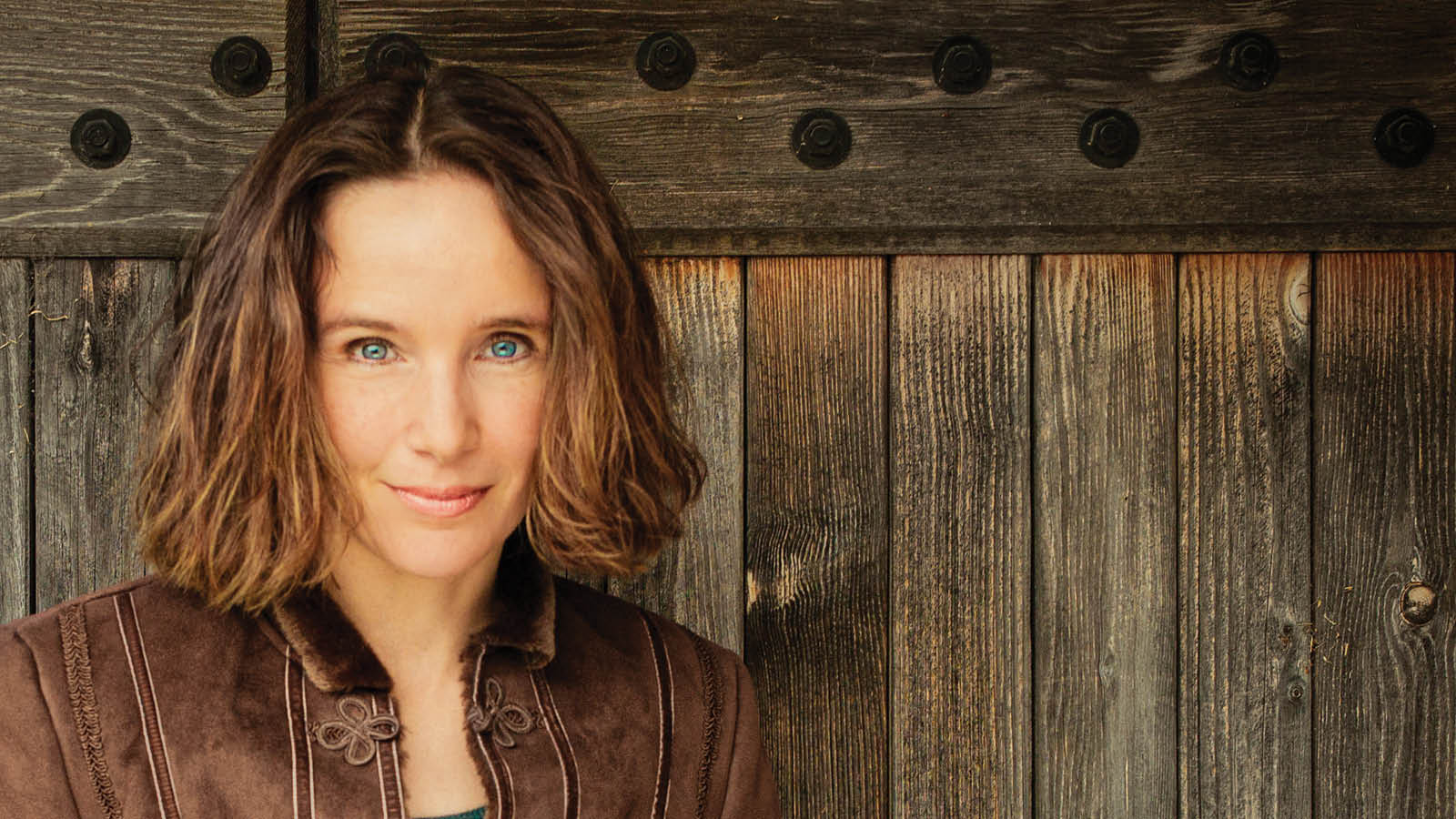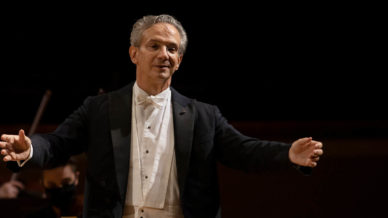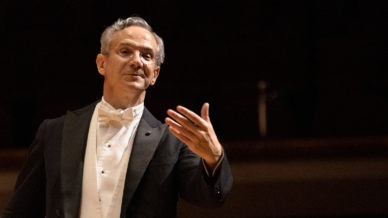

Hélène Grimaud Plays Brahms
October 7 – 9, 2022
FABIO LUISI conducts
HÉLÈNE GRIMAUD piano
BRAHMS Concerto No. 1 in D minor for Piano and Orchestra
FRANCK Symphony in D minor
Wildlife conservationist, activist, writer and virtuosic pianist, Hélène Grimaud returns to Dallas to perform Brahms’ First Piano Concerto, the composer’s first performed orchestral work. Grimaud’s thoughtful and tenderly expressive music making will ignite our emotions.
Following the Brahms, explore Franck’s Symphony in D minor. Cyclical and thematic, Franck’s symphony draws inspiration from Germanic musical tradition and Beethoven to form a creative and enthusiastic work. A popular piece in its day and considered to be French music’s most significant late-19th century symphony, the Franck is being reintroduced by conductors, like Fabio Luisi, with a passion for exposing lost masterpieces to new audiences.

Program Notes
by René Spencer Saller
Brahms’s Piano Concerto No. 1 in D Minor is a radical, turbulent work with a long
and tortured gestation period. During the nearly five years that elapsed between the
preliminary sketches and the final revisions, Brahms was living out a soap opera. In
the winter of 1854, his cherished mentor Robert Schumann threw himself into the
Rhine and was sent to a sanatorium, where he would spend the rest of his life in
virtual exile, declining from delusional to nearly catatonic. Sadder still, his doctors
prohibited visits from his wife, Clara, a famous piano virtuosa and his greatest
champion, as well as the mother of their seven children.
As soon as he learned of Robert’s suicide attempt, Brahms rushed to the family’s aid,
living among them as man of the house. He and Clara became more than friends, if
not quite lovers. Although she was nearly 14 years his senior, Brahms wrote her
countless ardent letters. Yet when Robert died, in July 1856, Brahms did not ask
Clara to marry him and made it clear that he never would. She remained his beloved
muse, collaborator, and confidante, but he craved freedom. For the rest of his life, he
would have sex with prostitutes while carrying on intimate but platonic affairs with
the women he respected, admired, and loved.
Turmoil and Transformation
Before the First Piano Concerto was a concerto, it was a sonata for two pianos and
then a symphony. Brahms, an inexperienced orchestrator in his early 20s, became
blocked and put the project aside for two years, until Robert’s death compelled him
to revisit it. He struggled with the score, now a piano concerto, for another three
years, scrapping most of his preliminary efforts but retaining the tumultuous
opening.
Even after all the angst surrounding the composition of the D Minor Concerto,
Brahms was feeling hopeful about its first performances. He was the soloist, and
rehearsals had gone splendidly. But after a coolly polite reception in Hanover, its
official premiere at the prestigious Leipzig Gewandhaus was an unqualified disaster.
He played well, but everyone, even the conductor, hated the music. Brahms tried to
take it in stride, writing to an old friend that “the failure has made no impression
whatever on me…. After all, I’m only experimenting and feeling my way as yet. But
the hissing was too much of a good thing, wasn’t it?”
Despite his attempt at humor, the failure did affect him. He continued to compose, in
his painstaking, self-critical way, but he waited another 15 years before he offered
the public another original work of similar ambition.
A Closer Listen
The first movement is in sonata form, but only to a point. There are wrenching
breaks, themes shoving each other aside in the harmonic welter. The first measures
are studded with “devilish” tritone intervals, shockingly dissonant to Brahms’s
contemporaries and still unsettling today. As Brahms biographer Jan Swafford
explained, “the beginning of the Concerto evoked the tragedy that preceded its
inspiration by a few days: Robert Schumann’s leap into the Rhine…. If the
vertiginous opening moments of the concerto are applied to the image of a
desperate man leaping into the water, they become almost cinematically, kinetically
apt.”
The serene and radiant Adagio originally bore a religious inscription, a benediction
from the Latin mass. Devotional in tone, the second movement is both an elegy for
Robert and a “tender portrait,” in Brahms’s own words, of Clara, whom he had once
described as “going to the concert hall like a priestess to the altar.”
The assertive, driving finale follows a traditional rondo form and seems particularly
indebted to Beethoven’s Piano Concerto No. 3 in C Minor.
César Franck’s Symphony in D minor displays the Belgian-born French composer’s
love for the organ tradition of his adopted country and the German Romanticism of
his musical idols, Beethoven, Liszt, and Wagner. Invoking the latter three influences
was an especially risky move in the wake of the Franco-Prussian war, when anti-
German sentiment in France was at a fever pitch. Thanks to this rotten
concatenation of timing, history, and luck, the Paris premiere was a flop. Franck died
before his fellow countrymen could overcome their German animus enough to
appreciate the D minor Symphony’s radical genius.
Late Masterpiece
As a composer, Franck was something of a late bloomer, although his life in music
began in early childhood. Franck’s domineering father pushed him into the role of
child prodigy on the piano-recital circuit, and Franck was relieved when he grew out
of that unwanted gig. Studious and introspective, he preferred poring over his
counterpoint exercises and playing the organ to competitive concertizing. After he
moved out of his parents’ home, in his early 20s, he supported himself by teaching
music.
A few years later, after his marriage, Franck became a church organist, a position he
retained for the rest of his life. Like Saint-Saëns and Messiaen, he recognized the
true value of this vocation. More than a steady income, it meant access to the finest,
state-of-the-art music technology. Think of the organ as an entire orchestra playable
by a single musician: what better tool for a symphonic composer in the pre-digital
era?
His Symphony in D minor—Franck’s sole contribution to the genre, aside from a
long-lost juvenile effort—is that rare thing: a late-life masterpiece. He was 66 when
he finished it, and he died a year later. Many music writers consider it the greatest
symphony composed in France during the latter part of the 19th century.
Organic Germanic
Although Franck didn’t include an organ in the score (as Saint-Saëns famously did in
his Third Symphony), the organ haunts the symphony regardless. It’s a sepulchral
presence that imbues the work with what its admirers call grandeur and its
detractors call stodginess. Over the years, Franck’s symphony has fallen in and out
of favor, which says more about the fickle tastemakers who police the canon than it
does about the quality of Franck’s music. Although the symphony is widely admired
today, its Germanic odor offended audiences at the 1889 Paris premiere. Maurice
Ravel panned the symphony’s orchestration, Charles Gounod called it
“incompetence pushed to dogmatic lengths,” and the capital’s leading conductor,
Charles Lamoreux, declined to perform the work until after Franck’s death.
A Closer Listen
The first bar contains the work’s master theme, a three-note pattern from which all
future melodic material is derived. This opening volley unapologetically celebrates
one German master in particular: Beethoven. For his central motif, Franck borrowed
a musical phrase from the fragmentary final movement of Beethoven’s last string
quartet. The phrase is known as “Muss es sein?” (“Must it be?) because Beethoven
wrote these words on the manuscript.
Asked what inspired him to compose the symphony, Franck replied that it was “just
music, nothing but pure music.” He did, however, apply the term “classical” to his
symphony as well as a few descriptive phrases to each movement. The first
movement, he said, was “energetic and warm.” He called his favorite movement, the
central Allegretto, “sweet and melancholy,” adding that it was inspired by a far-off
funeral procession. The brass-dominated, thematically recursive finale was, to his
ears, “radiant and quasi-luminous.”




